The ancient Caledonian pinewoods near our Springwatch base at the Dell of Abernethy are rich in wildlife, but not all of it thrives in deep dark forest. We took a stroll a couple of days ago and stumbled on a sunlit clearing, which used to be a timber yard. This natural amphitheatre is a stage for some wonderful insects and spiders.
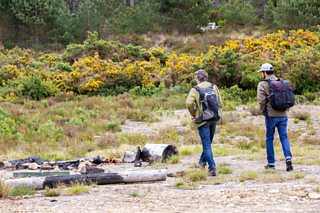
Brett Westwood and digital team member, Nick Jones, stroll through an old timber yard looking for invertebrates. Photo by Ben Morrison.
We were on the hunt for the star of the show, one of Britain's biggest and most spectacular flies. But our first encounters were with the supporting cast including green tiger beetles, which flashed brilliant emerald as they ran over the stony ground. They're the fastest- running of all beetles and chase down other insects, seizing them in huge jaws. Their larvae are just as well-equipped and live in burrows, which they block with their heads. When an ant or other insect runs past, they seize it and drain it of vital fluids.
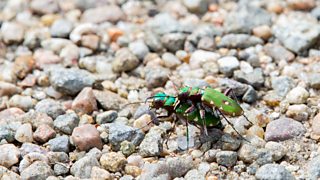
Two green tiger beetles mating. Photo by Ben Morrison.
There were lots of ants in the clearing and when we examined their nest under a piece of old timber, it was confusing at first ...some ants were red and others were black. We soon realised that this was a colony of slave-maker ants, which raid the nests of a different species of lack ants and carry away their pupae. The black ants are raised in the nests of the slave-makers where they are controlled by chemicals called pheromones to perform tasks alongside the slave-maker workers. They are enslaved by the chemicals and can't return to their own nests.
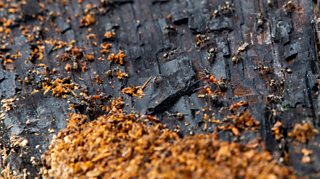
The black ants in this image are being raised in the nests of slave-maker ants and manipulated with pheromones to act as workers in the colony. Photo by Ben Morrison
The old timber yard was alive with spiders. Some were hunting prey but others were being hunted. One large specimen was being carried by a black and red pompilid wasp, which was a fraction of its weight -the equivalent of us carrying a wardrobe on our backs. The wasp paralyses the spider to keep it fresh, drags it into a burrow and lays an egg on it. When the egg hatches, the wasp grub feasts on the living but immobilised spider -gruesome!
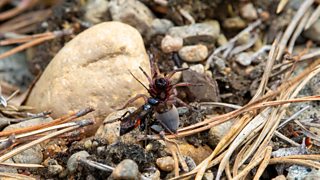
A black and red pompilid wasp drags a paralysed spider towards its burrow to lay an egg on it. Photo by Ben Morrison.
There were longhorn beetles emerging from the old timber too but they were in peril. The main attraction was lurking on an old piece of cut timber nearby, a huge bumblebee robber fly, found in the UK only in a few Scottish pinewoods. This impressive furry fly, which resembles a bumblebee, is a predator, which grabs insects as large as longhorn beetles in flight and sucks them dry. Its larvae live in tunnels in old pine trees where they prey on beetle grubs.
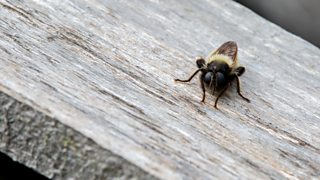
A bumblebee robber fly pauses on an old piece of cut timber. Photo by Ben Morrison.
We were thrilled to see this rare and charismatic insect in a brief burst of sunshine at the beginning of its flight season. A brilliant afternoon!
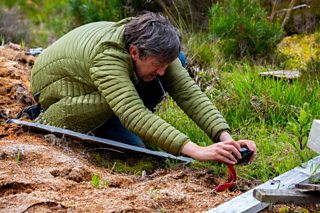
Brett Westwood captures a close up shot of a bumblebee robber fly. Photo by Ben Morrison.
